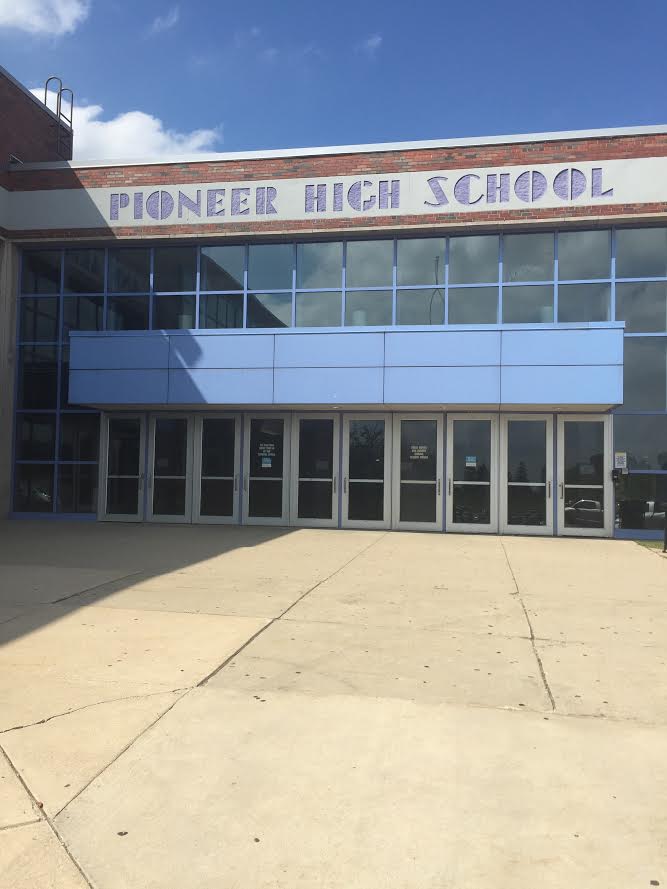Lost in the Tide
Freshman Anda Jiang vividly remembers her very first day at Pioneer High School. Stepping into the counseling office, she was confronted by the long line of anxious students waiting to solve their own schedule conflicts. Frantic counselors elbowed one another to gain control of the one computer that could override class enrollments as even more students filed into the room. After about an hour of waiting, she was greeted by a counselor with a terrible headache developed from a morning’s worth of students’ needs. Jiang couldn’t help but feel sorry. After all, in a school of nearly 2,000 students, things can easily become overwhelming.
“It was kind of insanity,” Jiang said, recalling the confusing, chaotic day.
However, Jiang remembers that the confusion only continued. She didn’t have a desk for the first week of her French class and needed to write on her lap until one was finally available for use. In fact, most of her classes started to run out of seats, a clear sign of the consequences of one of the largest freshman classes in Pioneer’s history.
For teachers and students alike, larger classes can create more stress. It can also lead to a lack of individual attention as teachers struggle to oversee all students’ needs.
“It can be harder to connect with a teacher and get an education adapted to your learning preferences,” Jiang said.
Senior Annie Zhou shares a similar thought regarding the student to teacher ratio. It affects her in a way that “learning experience is less personal.”
Teachers embody this stress, too. Although they were warned about the rising number of students, overflowing classes can take frequent tolls and wreak havoc on their jobs. Jiang’s English teacher, Maria Montri, a graduate of Pioneer herself, notices the struggles that teachers face.
“We’ve all had our days where we’re so overwhelmed that we feel we’re going to lose our minds,” Montri said. “But we take a deep breath and keep moving on.”
Montri tries to make the best of the overflowing numbers of students in her classes. She emphasizes pacing her workload, not just for the benefit of herself, but for the benefit of her own students. She considers herself “lucky,” because her largest class totals only 32.
Not only are overcrowding classes a problem, but another major consequence of the overcrowding in the school is hallway safety. As soon as the bells ring, streams of students fill up every crevice, gradually evolving into a flood of hundreds who jam into each other on stairways.
“It sucks,” Jiang says, “way too many people.” “The stairways are always packed.”
Maryam Alavi, a friend of Jiang since middle school, agrees. Even getting from one class to another can be hell, she says. The students who tower over the clusters of bodies have it easy, but at just 5-foot-1-inch, it can get beyond frustrating for Alavi to navigate agitated students at every turn.
“One time when I was walking, I almost fell off the stairs,” Alavi said. “There’s so many kids getting out of the same hallways and stairways to the point it can become a safety hazard.”
It is difficult not to get lost in the overwhelming tide of people, but there are also students who stand in clusters to socialize and block the restless footsteps of those who can’t afford to be marked tardy.
“It’s a big hold up and no one can get through. It’s a problem for a lot of kids,” Alavi said.
This isn’t the first time Pioneer has had a large student enrollment. According to a former graduate of 1969, Ruth Crawford, there were approximately 1,000 students in each class (grades 10 to 12). Pioneer was the only public high school, as Huron High School was being built at the time. The school’s solution to accommodate all the Pioneer and Huron students? Pioneer students would come during the first half of the day, while the Huron students came during the second half.
“The classes weren’t overcrowded, it was pretty much normal,” Crawford said. “Usually, there were about 25-30 students in each class.” Unfortunately, this is no longer the case for Pioneer students.
Like many other students, Jiang’s largest class is well over 35 students. Jiang, Alavi, and others share concerns about how the year will progress. Competitions may arise as one-on-one time with teachers becomes less frequent. Navigating crowded stairwells will continue to be a necessary skill to stay safe and get to class on time in order to steer away from the pandemonium that may disrupt students’ order of high school life.
Pioneer is a large school, but students and teachers both recognize that a growing number in a limited space creates stress.
“It’s something we have to learn to live with,” said Jiang. “I guess you could call it organized chaos.”


